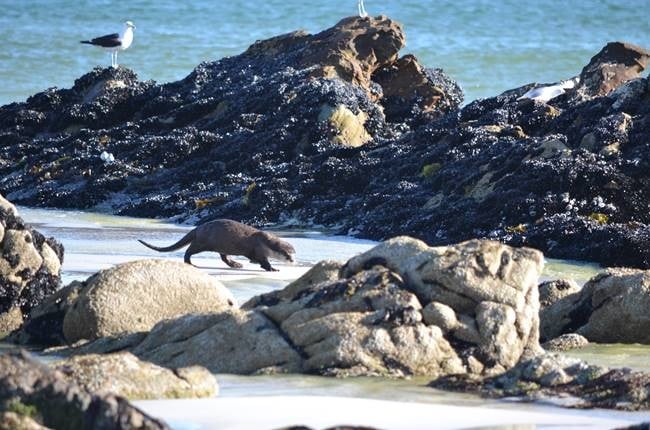
Dr Nicola Okes is a South African conservation biologist with a special interest in species inhabiting marine and coastal environments. In 2017 she completed her PhD at the University of Cape Town where she focused on the conservation ecology of African clawless otters in an urban environment.
Did you know that there are thirteen species of otters found around the world? South Africa is home to two of them!
The African clawless otter, found throughout the country, and the Spotted Necked otter, found mostly in the north and eastern half of the country.
Both of these otter species live in and near freshwater rivers and lakes, but the Cape, or African, Clawless otter also lives in wetlands, estuaries and marine environments.
They are unique in that they are the only otter species that has no claws, and their highly dexterous ‘fingers’ allow them to easily feel under rocks and catch their prey, such as fish, crabs and crayfish.
Their lack of claws also makes their footprints easy to spot on in the sand, and paths of otter spoor can often be seen in the early mornings along rivers flowing onto many of South Africa’s beaches.
The most secretive mammals
Otters are mostly crepuscular, meaning they are active in the early mornings and late evenings, and thus are rarely seen.
They are some of the most secretive mammals and are a delight to see, especially when diving and playing in their natural habitat.
If you have been lucky to see an otter diving, swimming and playing in water, you might be surprised to know that otters are not born water-savvy.
They have to learn to swim, and their mothers teach them this at a young age. Otter pups are born blind and leave the holt (an otters den) when they are around 4 weeks old to join their mother on foraging trips and to learn to swim.
If you haven’t – check out their playful swimming abilities here:
They belong to weasel family, the group of animals that includes weasels and red pandas,and their closest relative in South Africa would most likely be the notoriously feisty Honey Badger.
Otter conservation
On occasion when young otter pups have been separated from their mothers and have been rescued, it is up to the rehabilitation team and vets at zoo’s to teach them to swim before releasing them into the wild.
Otters have intrigued animal lovers and scientists alike for decades, and organisations like the International Otter Fund and the IUCN/SSC Otter Specialist Group have been founded over the years to help both fund and conduct research into how best to conserve these mammals all around the world.
Each year, to raise awareness on otter conservation groups such as these celebrate International Otter Day, which falls every year on the last Wednesday in May.
Want to know even more about otters?
Learn how to be an otter from this story below or on YouTube, or visit Oscar the Otter here:
Chat back:
Share your story with Parent24. Anonymous contributions are welcome.
Email: Share your story with us via email at chatback @ parent24.com




 Publications
Publications
 Partners
Partners
















